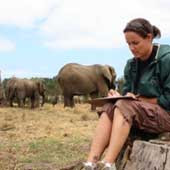
This 11-day course offers insight into essential techniques used in wildlife research, using the magnificent African elephant as an example. Based at the Knysna Elephant Park on the Garden Route, South Africa the course is run by AERU (African Elephant Research Unit) and includes lectures on many aspects of elephant biology, behaviour and welfare. Each theory session is accompanied by a practical lesson ‘in the field’, allowing you to put theory into practice with 9 beautiful elephants based at the Park and others at similar facilities.
‘Understanding Elephants’ provides an excellent foundation for anyone interested in working with animals and aims to offer you a broad knowledge base by covering the key areas of elephant research, which can be applied to other animals in both wild and captive environments. 'Understanding Elephants' is also ideal for enthusiasts wanting a more hands on, educational (and unforgettable!) experience. You will work alongside experienced field researchers gaining theoretical and practical knowledge that is essential for careers in wildlife research, zoology, or conservation. You will have an opportunity to learn about elephant behavior, anatomy, cognition and conservation with our resident herd and participate in ongoing studies and training. Once you are comfortable with our herd, we will take a few days to visit a sister elephant facility for further observation and observe wild elephant on a game drive at a nearby game reserve.
Course Dates
2012: 2 - 13 Aug 30 Aug - 10 Sept
2013: 11 - 22 Apr 18 - 29 Jul 22 Aug - 2 Sept
For more information, please contact aeru@knysnaelephantpark.co.za








